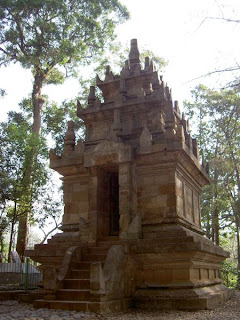Inspired by the writings of Djakarta Tempo Doeloe by Abah Alwi,
who relates that Prince Diponegoro was imprisoned in Staadhuis (now the Museum Fatahillah), so I persuaded my friends to take a walk to the Museum Fatahillah last year.
Why would I want to know? It's because of Prince Diponegoro was my ancestor.
The Jakarta History Museum (Museum Sejarah Jakarta), which is also known as Fatahillah Museum or Batavia Museum, is located in the Old Town of Jakarta, Indonesia. The building was built in 1710 as the Stadhuis (city hall) of Batavia. It was opened in 1974, displays objects from the prehistoric times of the city, the founding of Jayakarta in 1527, and through Dutch colonization from the 16th century onwards until Indonesia’s Independence in 1945.
You guys, who live in Jakarta, should visit here at least once, to know the history of the city where you live.
The Museum has a collection of around 23,500 objects, some of them inherited from de Oude Bataviasche Museum (now the Wayang Museum). The collection includes objects from the Dutch East Indies Company, historic maps, paintings, ceramics, furnitures, and archeological objects from the prehistoric era such as ancient inscriptions and sword. It also contains the richest collection of Betawi style furnitures from the 17th to the 19th century.
You can find a replica of the Tugu Inscription from the age of Great King Purnawarman, which is the evidence that the center of the Kingdom of Tarumanegara was located around the seaport of Tanjung Priok on the coast of Jakarta. There is also a replica of the 16th century map of the Portuguese Padrao Monument, a historical evidence of the ancient Sunda Kelapa Harbor. It's so interesting, right?
Okay, back to the topic.
Nobody knew where the room who had 'occupied' Diponegoro, at the colonial building. It's not reported at all in Javasche Courant (State) and other newspapers about the event of Diponegoro's arrival in Batavia in 1830.
I can imagine the shock that occurred during the arrest of Prince Diponegoro at the negotiating table with the Dutch colonial rulers. How very cunning!
He was arrested in Magelang on March 28, 1830. After conducting a five-year uprising. Victims of the Netherlands as many as 15 thousand people. On the Diponegoro's 30 thousand people. Victims of the people is much greater. Around 180 thousand people in Java died during the war five years. The material losses of 20 million Dutch guilders, a huge amount at the time.
You can see,
the people loved Prince Diponegoro and want to fight with him. Because they think the Prince is a true king, although he has handed over his crown to his brother for the sake of fighting against invaders.
It was a debate about how long the prince lived in Staadhuis. But definitely, he is treated with respect. Not placed in a narrow cell with common criminals. That said, he was placed in a room on the second floor of the building. Of course, he got good food and drinks.
At the Museum Fatahillah, there are a number of narrow dungeon, dark and chest-high water flooded. The prisons is also called water prisons. The followers of Prince Diponegoro was arrested here. According to records, Untung Surapati also been arrested here, but managed to escape.
Wow, I imagine how great Bang Untung Surapati! You see, because the legs of each prisoner weighted by a 100 kg steel ball. But according to the story, Untung Surapati assisted by Suzanna, a daughter of an East India Company officials who loved him. Suzanna managed to bribe the guards to release Untung. How beautiful love is! :)
Looks like my visit to Museum Fatahillah could find no obvious trace of the existence of my ancestor. No one knows for sure the room where the prince held captive before exiled to Manado.
Oh by the way,
on the second floor of City Hall, there are Raden Saleh's paintings titled 'Capture of Diponegoro' which he completed 1858. Unlike other painters who depict the colonial perspective, without a doubt Raden Saleh shows how the expression of Diponegoro as the moral winner, who walked into the jail with a facial challenge his enemies. Including a commander of the VOC challenge.
That's an anti-colonial revolutionary painting. No wonder this painting was only brought back to Jakarta by the Dutch after Indonesia's independence. Diponegoro, in the painting wearing the robes and turban. On his belt dangle a 'tasbih' (moslem rosary).
It shows that he is a devout patriot.
I felt proud looking at the painting :)
 |
| Raden Saleh's painting about Prince Diponegoro |
 |
| My friend Kiki and the statue of Hermes |
 |
| Me & my friends take a look at the water prisons |
 |
| The VOC's cannon |
 |
| The chest-high water prison. But now it's not flooded |
 |
| The Fatahillah Museum formerly known as Stadhuis |
 |
| the governor general's dining table |
 |
| Zaky, Kiki's son, in front of the dungeon |
 |
| Iron balls for the prisoners (all of the picts is mine except this pict by Aroengbinang Project) |





































 Will & Kate. Cinderella's Wedding
Will & Kate. Cinderella's Wedding






